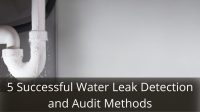5 Successful Water Leak Detection and Audit Methods
A water leak is a very expensive and dangerous thing to have in your home. This article will teach you 5 different methods of how water leak detection will locate leaks. If you follow these steps, you will be able to detect a leak before it becomes too severe and costly.

-Inspect the water meter for any unusual readings
-Check your home’s exterior for wet spots or stains
-Check for any signs of a broken or loose pipe, such as discolouring, pitting or bulging.
-Listen for running water in the walls and ceilings; you can also check for water stains on the ceilings.
-Inspect all of your faucets and pipes, both inside and outside.
How to detect water leaks and perform audits
A leak can be found by turning off all the water sources of your home and monitoring for any flow, drip or drop. If you detect a sound that seems like it is coming from underground, this could be a leak. If you are looking for leaks within the home, it is best to look in areas where plumbing pipes intersect with other piping and at any joint or connection between connected parts. The best time to check for water leaks is at night when there are fewer people using the water. This will help you to detect a leak faster as less water will be used while you are investigating.
A water meter can be used to detect a leak and is the most effective way of finding one, but it requires some knowledge of how to read it. The easiest way to check for a leak is to simply check all of your faucets and water-using appliances for a loss of pressure. If you have an older home with a cast iron pipe, it can be helpful to listen for a change in the sound of water running through it. The sound will change to a more hollow sound if there is a leak, as opposed to the normal gurgling noise.
If you notice a drop in your water pressure or hear an unusual sound, you should turn off the main valve to your home. Then check all of your faucets and appliances for leaks by turning them on and off. And if you find a leak, there are several ways to repair it depending on where the leak is located:
If your toilet has a small leak, you can add an inexpensive wax ring to the base of your toilet to stop the leak. If you find a leak near one of your faucets, you can replace an old washer on it with a new one that will stop the leak. And if you notice a leak in your outside pipes, you should contact a plumber to repair it for you. Also, if the pipe is underground, be sure to find out if there
How to prevent water leaks
A leak can cause a water bill to be significantly higher than normal. If your water company records show that you have been using more of the precious liquid per month, it may be time for a leak detection audit. Inspect your home’s water supply lines to check for leaks and make sure that all of the connections are tightly sealed. Another way to detect a leak is to use the water meter. It is usually found in the basement or utility room and will have a dial that can be read like a clock.
If you suspect that you have leaks, you can also use a dye tablet to check for leaks. First, turn off all of the water in your home and flush out any toilets or other plumbing fixtures that may contain residual water. Then place the dye tablet into a toilet tank or other plumbing fixture and wait for about 30 minutes. If you notice any coloured water coming from the faucets, toilets, or drains in your home, then you probably have a leak. The final way to detect water leaks is by the use of an electronic leak detector or “Leak-Detector Pen”. You can find these pens in major hardware
How to fix water leaks
Water leaks are expensive to fix and can cause real problems. They’re also easy to detect, and you don’t need a team of experts or complicated tools. The following five methods will help you find the water leaks in your home:
1. Check for damp spots on basement walls or ceilings near sinks or toilets. These are often signs of a leaky toilet flapper valve that needs to be replaced or a leaky faucet.
2. Check for damp spots on the floor near sinks, toilets and other water fixtures. These are signs of leaking pipes that need to be replaced.
3. Listen for dripping water when no one is using the faucet or toilet, and check to see if any of them are leaking.
4. Check your water meter before and after a two-hour period when no water is being used. If the meter spins faster than usual, you may have a leak somewhere in your home.
5. Check for damp spots on the outside of your home. These may be signs of a leaky pipe or a broken water main, which can cause flooding in your yard and damage to your foundation.
How to save water from leaks
Leaks are the leading cause of water loss and can be prevented with regular audits. Methods to detect leaks include Visual inspection; Checking valves on tanks or pipes; Flowing water meter; and Continuous water meter. Visual inspection is the cheapest and easiest way to find leaks in a building. Check valves on tanks or pipes can indicate that there is a leak somewhere, but this isn’t always the case. Flowing water meter methods are more accurate, but they can be expensive and time-consuming to implement. Continuous water meters provide the most accurate reading of all leak detection methods, but they are also the most expensive.
How to reduce your water bill from leaks
“Auditing your water and wastewater systems is the best way to find leaky pipes. You can do this in a few different ways, including physically walking around with a hose or listening for leaks.”
“A home audit can be done with a bucket and some soapy water. Simply pour the soap onto the ground near your house’s foundation, then look for bubbles in the bucket. Bubbles mean you have a leak.”
“A more accurate way to find water leaks is with an electronic detector that measures the conductivity of your pipes and alerts you when it detects a change.”
“This is a great way to find water leaks around your home, but it can be expensive. If you’re looking for a cheaper option, try using the hose and bucket method. If you’re still struggling to find the problem, consider hiring a professional plumber.”




